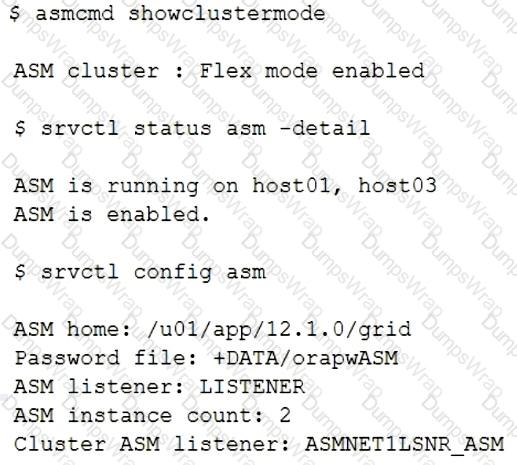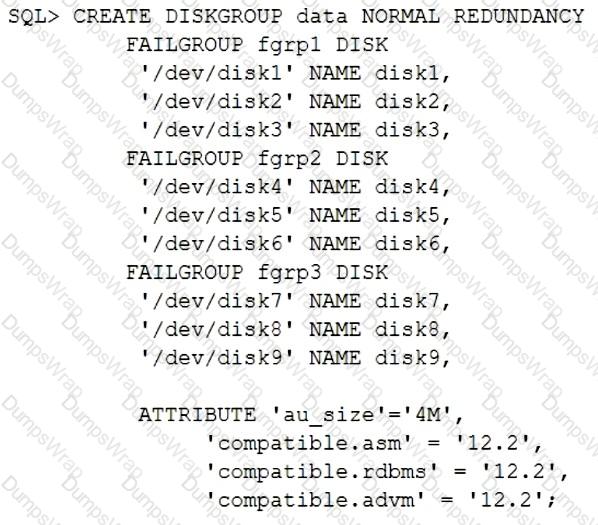Oracle Database 19c: RAC, ASM, and Grid Infrastructure Administration Questions and Answers
Which two statements are true regarding the default service that is automatically created upon PDB creation in a RAC database environment? (Choose two.)
Which statement describes the purpose ofcolocation_tagfor client routing with Oracle database 19c?
Which two statements are true about the Global Enqueue Service, Instance Locks, and global enqueues in Oracle 19c RAC? (Choose two.)
Identify three prerequisites for the successful installation of Oracle Grid Infrastructure 19c when using Full Featured Grid Naming Service (GNS). (Choose three.)
You support a RAC database with these characteristics:
1. There are six instances.
2. Server Pool prod has a maximum of four servers.
3. CRM is a policy managed, uniform service using Server Poolprod.
4. ERP is a policy managed, singleton service using Server Poolprod.
5. Grid infrastructure is installed and running in its default configuration.
Which four benefits are provided by this configuration in Oracle 19c? (Choose four.)
Your four-node cluster runs Oracle 19c Clusterware and supports a mix of RAC databases from Oracle 10g Release 2 to Oracle 19c.
All databases have one or more services defined.
The Oracle 10g Release 2 database clients connect to the database instances using the public VIP.
The Oracle 11g Release 2, 12c Release 1, and 19c clients connect to the database instances using the Single Client Access Name (SCAN).
You must change the public VIPs.
Which three actions must be performed to change the VIPs onhost01, the first node in the cluster? (Choose three.)
Examine this query and output:

Performance analysis revealed severe SQ enqueue contention on the SEQ1 sequence.
TheSEQ1sequence is incremented from all instances equally and is frequently used.
Which two statements should you execute to reduce SQ enqueue contention? (Choose two.)
Which three statements are true about ASM Cloud File System (ACFS) replication? (Choose three.)
Which two methods exist for enabling the collection of additional resource debugging information for specific resources controlled by Oracle 19c Clusterware? (Choose two.)
Secure Cluster Communication protects the cluster interconnect from common security threats when used together with Single Network Support. Secure Cluster Communication includes message digest mechanisms, protection against fuzzing, and uses Transport Layer Security (TLS) to provide privacy and data integrity between the cluster members.
Which statement is true about securing cluster interconnect communication?
Which three statements are true about services and load balancing for Oracle 19c clients connecting to Oracle 19c RAC database instances? (Choose three.)
Which three statements are true concerning Automatic Database Diagnostic Monitor (ADDM) for RAC? (Choose three.)
Which two statements are true aboutv$asm-views in a clustered environment? (Choose two.)
Which two statements are true about Transparent Application Continuity in Oracle RAC 19c? (Choose two.)
Which two statements are true about resources defined by an administrator and registered with Oracle 19c Clusterware for high availability? (Choose two.)
Examine the output of theasmcmdandsrvctlcommands:

Then you execute this command:
$ srvctl relocate asm -currentnode host03 -targetnode host02
Which three statements are true regarding the execution of this command based on the output shown? (Choose three.)
A Java application using thickJDBCconnections will soon be deployed, and you must configure a RAC database to support highly available connections.
Broken connections must be re-established as quickly as possible.
Which feature will support this requirement?
Which two statements are true about load balancing using a database service in a RAC environment? (Choose two.)
Examine this command:

Which two statements are true about this disk group, created using Grid Infrastructure 19c? (Choose two.)
Which three resources are managed using global concurrency control in an Oracle 19c RAC multi-instance database? (Choose three.)
Which two statements are true regarding ASM Dynamic Volume Manager (ADVM)? (Choose two.)
Which three statements are true about fully qualified file names in ASM? (Choose three.)
Which two components must always be defined or specified by an administrator to make an application highly available using Oracle 92c Clusterware? (Choose two.)

